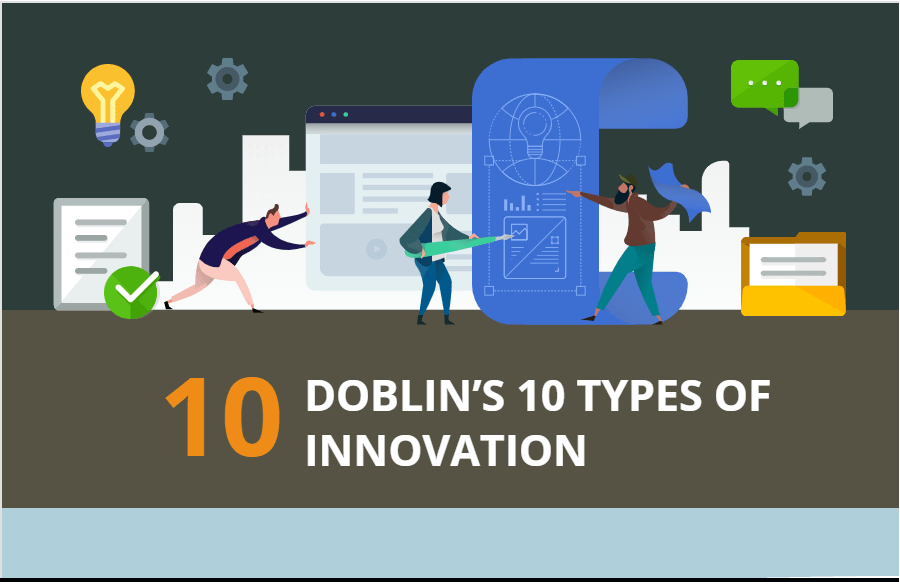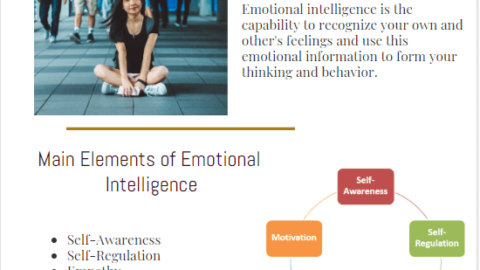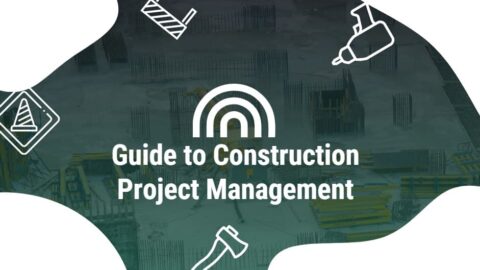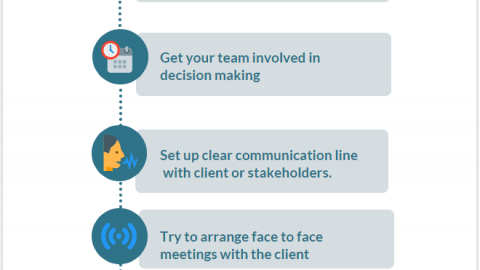Doblin’s 10 Types of Innovations with Examples
The Market is changing. In the Blink of an Eye. Doblin’s 10 Types of Innovation: Innovation is Your Only Imperative.
Table of Contents
Innovation distinguishes between a Leader and a Follower.
Steve Jobs
This article is based on Doblin Original 10 Types of Innovation. Dear Project Cubicle Reader, Welcome. If you are a returning reader, we’d like to thank you for your trust in our research and expertise and if this is your first article here, we’d like to officially Welcome You as a New Member of Our in-the-light-speed Growing Community.
Before Reading
In our articles, we present tips and techniques that we know will help you in both Your Business and Personal Growth. However, we believe in the unique power of creativity and for this reason we discuss these models, building their basis on analogies from our daily lives. By using these analogies, you can similarly also assure that you have a solid knowledge of the concerning subject.
By attempting to build a different analogy to describe the model we are going to talk about when you finish reading our articles, you may realize if you really have understood how to utilize the model.
We strongly suggest that you watch the videos of our articles that our Team puts together for you at least 2 times: once when you finish reading the article and second, a few days or maybe a week later to remember what we have discussed.
And finally, try to connect tips and techniques we discuss in your mind. After you establish this connection, we can assure you that the knowledge will keep adding up and by the light of the strong foundation you will have established, getting to know these new trends of industry will both be more beneficial and enthusiastic!
Without further ado, let’s begin deliberating Doblin’s 10 Types of Innovation Model.
Today in this article, we are going to build a massive stage. Based on Doblin’s 10 Types of Innovation Theoretical Model, Doblin’s 10 Types of Innovation Examples and Doblin Innovation Cards, we are going to, together, unveil the Art of Innovation. You might be wondering the reason we chose a Massive Stage for our analogy; we’d like to say that this model is rather a special one and as the theorist himself also prefers, using a stage to explain this theory will provide you with a 360-degree perspective around Doblin’s 10 Types of Innovation Model.
Innovation is Key. Only those who have the Agility to Change with the Market and Innovate Quickly, will Survive.
Robert T. Kiyosaki
Author of Rich Dad, Poor Dad
Now Ladies and Gentlemen, let’s imagine ourselves in the middle of an Ancient Theater, ornamented by statues in your right and left sides. This Ancient Theater is Massive and offers you a dreamy view of a Golden Fountain. Now please imagine that you are the first person in the audience, you came first, and you may sit on any seat you’d like.
Which view of the stage would you prefer?
Doblin’s 10 Types of Innovation Framework Explained
Doblin has built his stage analogy in the reverse direction of ours. However, we think that reversing the model will improve his analogy and help us have a better understanding of this exquisite model.
Below, you will see a model of Doblin’s 10 Types of Innovation which we have implemented into an analogy of an Ancient Greek Theater. We will furthermore discuss each component in detail and understand its unique place in Doblin’s 10 Types of Innovation.
At first, our analogy may seem like an enigma to you, but my promise: despacito;
We will slowly get there.
However before getting there, let’s get one thing straight:
Why do we Innovate?
- Competition
- Need for Change
- Need to Adapt the Change of Modern Technology
Innovation is the only Imperative, as commonly said in the Industry. In a world where everything changes in a blink of eye, the field of Business have left no chance but to catch up. Whether the innovation is about making a product more user-friendly or creating a more efficient finance model, Innovation is bound to happen.
The Key Word as you may have yourself realized is “More”.
What is the calculus of innovation? The calculus of innovation is quite simple: Knowledge drives Innovation, Innovation drives Productivity; productivity drives Economic Growth.
W. Ralph Brody
Innovation is about Improvement.
Improvement of the Business Landscape determines the Survival of Businesses in the Market.
Why do we Need Doblin’s 10 Types of Innovation Model?
- The Model Highlights all the areas where you can Innovate
- Helps you build an Innovative and Dynamic Business
- Makes it Very Difficult For Your Competitors to Copy Your Business Model
Innovation, like Change, is not a small word. It arises from various components. The existing innovations of companies can and should be studied, by breaking down to their components. Innovations succeed if they are systematically and structurally tactical.
So why do innovations fail?
According to Doblin, innovations Fail due to:
- Lack of Discipline
The Theorist states that this is the most common reason behind the failures of Innovation. We have discussed the importance of Discipline while discussing various models and theories, and in each of them we have put more emphasis on maintaining discipline. While discussing Leadership, we also said that lack of discipline may lead to over-friendly attitudes from your Team Members towards You, as the Team Leader.
Long story short, if it requires structured planning and determination, it requires Discipline. And lack of discipline may cost you.
- Focusing only on the products
As we will see below, innovation is not only about products. Therefore, only innovations solely related to products will fail, it is also about the process, your client’s experience, engagement with customers via applicable channels and so much more we are going to explore in the Dimensions of Doblin’s 10 Types of Innovation.
- Not analyzing the Existing Innovation Pattern in the Industry
Pretending you are the first to innovate in the industry will have disastrous consequences. Research. Be conscious of what you are doing and exactly, where? You should not attempt to innovate prior to following the current trend of your Industry. It is also likely that someone might already have brought the same idea into life, and you won’t know if you do not follow.
Long story short? Follow the Innovation Trend in Your Industry.
Now that we’ve got these straight, we can move onto the exciting Dimensions of Doblin’s 10 Types of Innovation Model at ease.
Please examine the schema of this Ancient Greek Theatre carefully.
Doblin’s 10 Types of Innovation: Dimentions
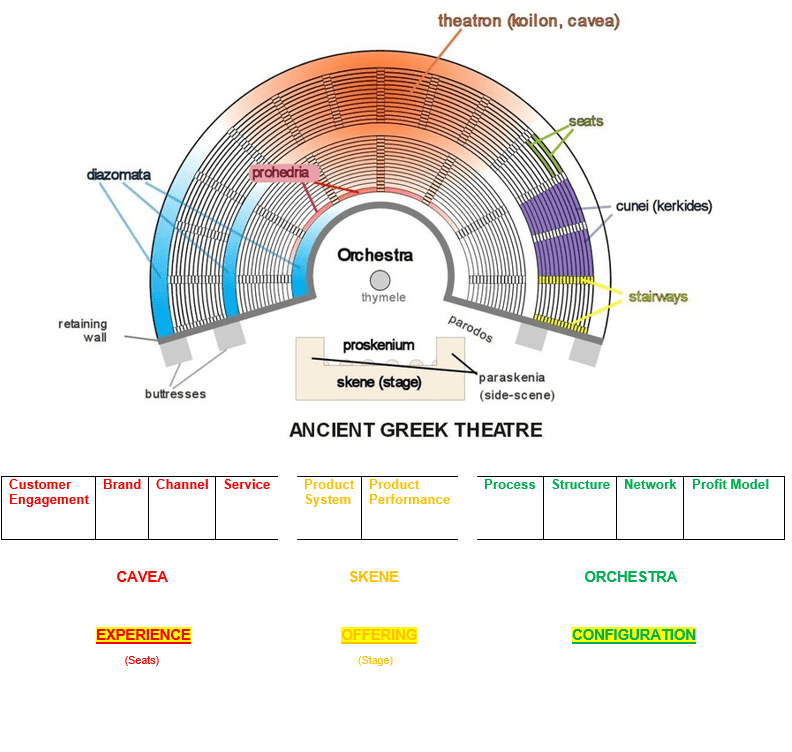
CONFIGURATION
With reference to our theater model, Configuration part is the orchestra of the entire structure. It consists of from the organization’s internal systems, functions, and core foundations. Doblin’s 10 Types of Innovation covers these systems under 4 subtitles:
- Process
- Structure
- Network
- Profit Model
Below, we are going to explore these models further, grounding ourselves in their original Doblin descriptions between the quotation marks.
1. Profit Model
“The Way in Which You Make Money”
Organizations survive through financial means; therefore, it will result in failure if the organization’s existing model cannot afford to innovate. The potential resources for innovation, either as a profit margin or an additional revenue, should be on the barrel.
2. Network
“Connections with Others to Create Value”
We are aware of the importance of networking, and that it is generally about “knowing the Right Person” in the industry. The Right Person then, in the future, become a new Client, a New Investor, or maybe a Partner. Having a Network in the Right Places is like myelinated brain cells. The Right Network will always be of benefit to you, and you should treat your connections as Assets to Your Business. By utilizing the gifts of efficient networking, you may also monitor and keep track of your competitions, and their innovations as much as the Latest Innovation Trends in Your Industry.
3. Structure
“Alignment of Your Talent and Assets”
Remember we said treat your connections as Assets? When it comes to Structure, everything is your Potential Asset. From the organization of your departments to physical activity in your office buildings and to assurance of the wellbeing of your employees.
The Structure of an Organization should be unique and sophisticated enough to make it very difficult for your competitors to replicate.
4. Process
“Signature or Superior Methods for Doing Your Work”
Process Innovation consists of Supply Chain and Logistics processes of an organization, starting from the delivery of the raw material to the production of the products.
OFFERING
Remember the ancient theater. Offering is the stage and what is being performed to the audience on the stage. To put it in the way of Doblin, an offering is organization’s Products and Services.
5. Product Performance
“Distinguishing Features and Functionality”
The Value of the Product. In other words, what are your customers’ or potential customers’ expectations, and can your product keep up or meet successfully with those expectations?
We should add that this is a constant ongoing process of change to innovate the product and assure that it meets the needs of the current competitive market.
6. Product System
“Complementary Products and Services”
This principle is about Sustainability of the Product’s System, furthermore creating relevant products and services that can be implemented and integrated to the existing product to satisfy needs of the customers.
Experience
Experience mainly focuses on the end user and their experience of the product/service. Experience is the seats of our ancient theater, the visible parts of the entire organization. What the customer sees and perceives.
7. Service
“Support and Enhancements that Surround Your Offerings”
The service is directly in front of the vision of your customer. Your clients are conscious of your offerings and purchase from you, due to these offerings. For this reason, whenever a company or an organization decides to innovate, they must assure that their innovation will enhance or enlarge the quality of the existing product.
8. Channel
“How Your Offerings are Delivered to Customers and Users”
Channel is about the means you use to engage with your customers. For an instance, Social Media is one of those means that you get to connect, get to know your customers or potential customers, and sell your products. The Channel gives you a solid idea about the current trends and what your customers specifically demand or are on the lookout for.
9. Brand
“Representation of Your Offerings and Business”
The Brand is who you are. Who/What is your organization and what is/are your vision(s)?
Having a strong brand strategy helps you connect to your clients and therefore lead them to have a positive image of your brand that they can feel connected. If your brand is known for its creative and efficient Innovations, then your brand will have built its foundation on an Innovation Cycle which will automatically drive your brand to continue with the only imperative the survive on the competitive market: Innovation.
10. Customer Engagement
“Distinctive Interactions You Foster”
Different from the Channel, this principle is about the interacting with the Customer itself via the products or services you offer. It is about gaining more information about their opinions of your product and therefore have a solid idea about the directions you can choose to innovate. What do your customers want?
There are different ways to find out the answer(s) of this question. One of them might be conducting creative and interactive surveys through different channels that your customers are utilizing; the other way may be reading their thoughts about your product on different channels, if applicable.
This is all about our exploration of Doblin 10 Types of Innovation Model.
What did we learn?
Let’s Review:
In this article we have discussed the Art of Innovation and how innovation is not only about changing a single process of your organization. We learned that an Innovation should be sophisticated and complex for your competitors to not be able to do the replica of your innovation and gain more profit. We also learned that 10 sides of Innovation in Doblin 10 Types of Innovation Model consist of Customer Engagement, Brand, Channel, Service, Product System and Product Performance, Process, Network, Structure and finally the Profit Model of our Organization/Company. We covered these principles on a foundation of an ancient Greek theater and attempted to build a 360-degree perspective to have a clearer understanding of Doblin 10 Types of Innovation Model.
And that is all we have to say here at Project Cubicle about Doblin 10 Types of Innovation Model.
For more information regarding the original theory of Doblin’s 10 Types of Innovation, see.
What do you think about Doblin 10 Types of Innovation Model?
Is there a theory you would like us to cover in another exciting article?
Let us know in the comments below!
Doblin 10 Types of Innovation Model Infographic
See Also
5 Stages of Tuckman’s Team Building Model

